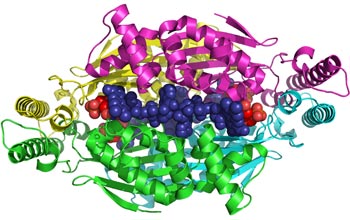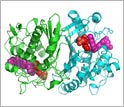|

Press Release 09-072
Scientists Discover New Chemical Reaction for DNA Production in Bacteria and Viruses

Findings could help lead to development of new antibacterial and antiviral drugs
April 16, 2009
A team of researchers has discovered a new chemical reaction for producing one of the four nucleotides, or building blocks, needed to build DNA. The reaction includes an unusual first step, or mechanism, and unlike other known reactions that produce the DNA building block, uses an enzyme that speeds up, or catalyzes, the reaction without bonding to any of the compounds, or substrates, in the reaction. The chemical reaction discovered by the researchers uses an enzyme called flavin-dependent thymidylate synthase, or FDTS. The enzyme is coded by the thyX gene and has been found primarily in bacteria and viruses, including several human pathogens and biological warfare agents. In the future, scientists may use this knowledge for the development of new antibacterial and antiviral drugs. Supported with partial funding from the National Science Foundation (NSF) and led by Amnon Kohen, an associate professor in the departments of chemistry and molecular and cellular biology at the University of Iowa, the team reports their findings in the April 16, 2009, issue of Nature, Letters section. Prior to the team's discovery, it was thought that thymidylate synthase, or TS, was the primary enzyme catalyzing a reaction that produced one of the four DNA building blocks called deoxy-thymidine monophosphate. The TS enzyme is coded by the thyA and TYMS genes and is present in most multi-cellular forms of life, including humans. Both the new and classical enzymatic reactions complete a key step in producing the DNA building block by adding a methyl group--one carbon atom attached to three hydrogen atoms--to the building block's precursor molecule called deoxy-uridine monophosphate, or dUMP. Even though both reactions accomplish this key step, the reaction mechanisms, or steps, catalyzed by the FDTS and TS enzymes are structurally different. Kohen and his team identified these differences using a traditional chemical method labeled isotopic substitution and a contemporary form of mass spectrometry using electron spray ionization. In particular, the team identified that the first step of the FTDS-catalyzed reaction involves the transfer of a proton and two electrons, known as a hydride, from a flavin co-factor molecule to dUMP whereas the first step of the TS-catalyzed reaction involves an amino acid from the enzyme's active site forming a bond with dUMP. "This work nicely illustrates how chemists using traditional techniques and contemporary instrumentation methods can make substantial contributions to important and interesting problems in biology," said Charles Pibel, a program director in NSF's Division of Chemistry. Since the two chemical reaction mechanisms used for the production of the DNA building block, and therefore DNA, are structurally different in humans and bacteria and viruses, and the enzymes used to catalyze the chemical reactions are different, the researchers' findings may assist with the development of structure-based antibiotics and antiviral drugs that selectively inhibit the activity of FDTS enzymes with little effect on TS enzymes--thereby combating pathogens causing anthrax, tuberculosis, botulism, syphilis, pneumonia, Lyme disease and other human diseases without interfering with human DNA synthesis. "The proposed new catalytic path of the FDTS enzyme appears to be so very different from that of the classical TS enzyme that we hope that specific inhibitors against it will have little effect on DNA production in humans and thus may lead to development of new drugs with low toxicity. Also, some aspects of the proposed chemistry are not common in enzymology or biological chemistry in general, making the future testing of this mechanism very interesting and of potential broader impact," said Kohen. Co-authors of the Nature Letter include: Eric M. Koehn and Todd Fleischmann, University of Iowa; John A. Conrad and Bruce A. Palfey, University of Michigan Medical School; Scott A. Lesley, The Joint Center for Structural Genomics at the Genomics Institute of Novartis Research Foundation; and Irimpan I. Mathews, Stanford Synchrotron Radiation Laboratory. The research was supported by NSF's Divisions of Chemistry and Molecular and Cellular Biosciences award number 0715448 and National Institutes of Health (NIH) award number R01 GM065368 to Amnon Kohen; the Iowa Center for Biocatalysis and Bioprocessing to Eric M. Koehn; NIH award number R01 GM61087 to Bruce A. Palfey; NIH training grant GM08270 to John A. Conrad; and The Joint Center for Structural Genomics grant U54GM074898 to Scott A. Lesley. Portions of the research, including using an x-ray source to help reveal enzyme structure and function, were carried out at the Stanford Synchrotron Radiation Laboratory (SSRL), a national user facility operated by Stanford University on behalf of the Department of Energy, OBER. The SSRL Structural Molecular Biology Program is supported by DOE, OBER and by NIH, NCRR, Biomedical Technology Program and National Institute of General Medical Sciences.
-NSF-

Media Contacts
Jennifer A. Grasswick, NSF (703) 292-4972 jgrasswi@nsf.gov
Diane E. Banegas, NSF (703) 292-8070 dbanegas@nsf.gov
Program Contacts
Charles D. Pibel, NSF (703) 292-4971 cpibel@nsf.gov
Principal Investigators
Amnon Kohen, University of Iowa (319) 335-0234 amnon-kohen@uiowa.edu
Related Websites
Nature Letter: An unusual mechanism of thymidylate biosynthesis in organisms containing the thyX gene: /news/longurl.cfm?id=154
Nature News and Views: Biochemistry: Anchors Away: /news/longurl.cfm?id=155
University of Iowa News Release: UI chemists' DNA biosynthesis discovery could lead to better antibiotics: /news/longurl.cfm?id=156

The National Science Foundation (NSF) is an independent federal agency that supports fundamental research and education across all fields of science and engineering. In fiscal year (FY) 2009, its budget is $9.5 billion, which includes $3.0 billion provided through the American Recovery and Reinvestment Act. NSF funds reach all 50 states through grants to over 1,900 universities and institutions. Each year, NSF receives about 44,400 competitive requests for funding, and makes over 11,500 new funding awards. NSF also awards over $400 million in professional and service contracts yearly.
 Get News Updates by Email Get News Updates by Email
Useful NSF Web Sites:
NSF Home Page: http://www.nsf.gov
NSF News: http://www.nsf.gov/news/
For the News Media: http://www.nsf.gov/news/newsroom.jsp
Science and Engineering Statistics: http://www.nsf.gov/statistics/
Awards Searches: http://www.nsf.gov/awardsearch/
| 


